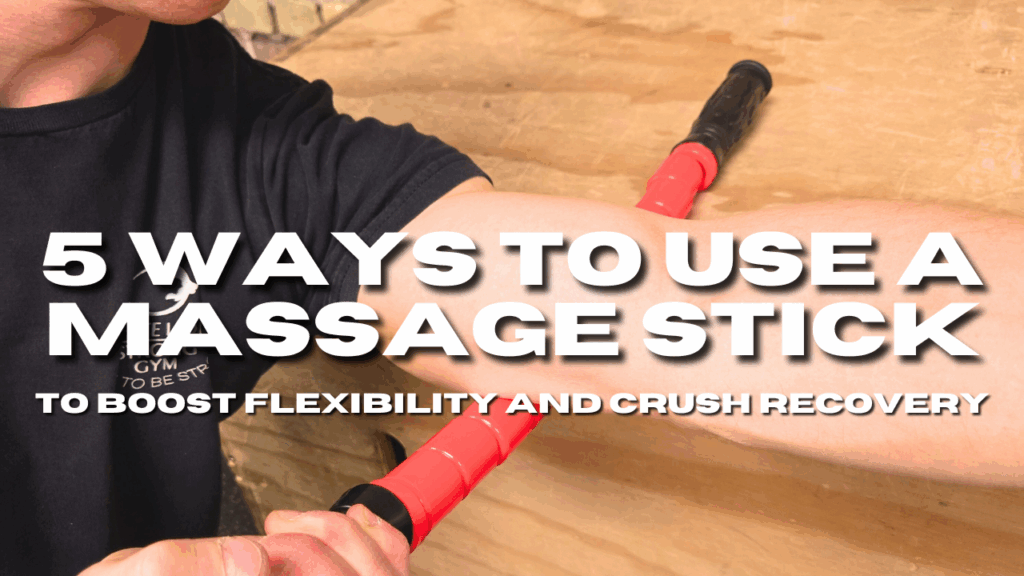
Keywords: massage stick techniques, how to use a massage stick, massage stick benefits, flexibility recovery guide
If you’ve been asking, “How exactly do I use this thing?” — this is your guide. With five simple yet effective techniques, you’ll learn how to use a massage stick to enhance flexibility, accelerate recovery, and maximize workout performance.
🌀 1. Quad Roll-Out for Deep Thigh Release
Why it works:
Targeting the quadriceps helps reduce tension, improves knee and hip range of motion—and activates the frontal chain before squat or lunge work.
How to do it:
- Sit or stand, place the stick horizontally on your thigh.
- Roll from just above the knee to the top of the quad.
- Use firm but gentle pressure—stop when you hit a tight spot and hold for 20–30 seconds.
- Repeat 2–3 times per leg.
Evidence check:
Self-myofascial rolling increases flexibility without reducing muscle force (Cheatham et al., 2015).
🦵 2. Hamstring Glide to Enhance Hip Mobility
Why it works:
Releases tension on the backside, helping with hip hinge mechanics and reducing low-back strain.
How to do it:
- Sit upright, legs extended.
- Roll from under your glutes to mid-hamstrings using smooth, even strokes.
- Where it’s tight, pause for 20 seconds.
- Repeat 2–3 times per side.
Pro Tip: After rolling, perform a hip-hinge stretch or glute activation to integrate the release.
🦶 3. Calf Roll + Dorsiflexion Prep
Why it works:
Tight calves can limit ankle extension and affect squat/jump mechanics. Rolling aids tissue elasticity and mobility.
How to do it:
- Sit with legs extended.
- Place the stick just above your ankle and roll upward to below your knee.
- Hold and breathe into tight spots.
- After each set, flex and point your foot to optimize release.
What the science says:
Rolling relies on mechanical and neurological effects—promoting increased muscle compliance (Behm & Wilke, 2019).
💪 4. Upper Back & Lat Release for Better Posture
Why it works:
Releasing these muscle groups improves posture, shoulder health, and breathing pattern—and supports heavy lifts like deadlifts and presses.
How to do it:
- Seated or standing, position the stick across your upper back or along your side (for lats).
- Roll up and down slowly, pausing on tight spots.
- Use controlled breathing to ease tension.
- Repeat 2–3 times each area.
Coach tip: Combine with deep breathing or thoracic rotations for better posture and mobility.
🎯 5. Trigger Point Hold for Actionable Release
Why it works:
A static hold on a tight spot increases sensitivity to release and calms neural tension—perfect for stubborn knots.
How to do it:
- Find a sore or “stuck” area (like near the glutes, quads, or traps).
- Apply firm pressure with the stick (not painful).
- Hold for 30–45 seconds.
- Breathe through it, then roll around the area afterward.
Why it’s effective:
Targeted SMR techniques can produce lasting improvements in mobility and reduced soreness (Wiewelhove et al., 2019).
🚀 Putting It All Together: A Sample Routine
Before workout (5–7 minutes total):
- Quad Roll – 1 minute
- Calf Roll + dorsiflexion – 1 minute
- Upper back roll – 1 minute
After workout (3–5 minutes):
- Hamstring roll – 1 minute
- Trigger point holds (as needed) – 2 minutes
Off days or recovery focus (8–10 minutes):
Cycle all five techniques to support daily flexibility and recovery.
💡 Pro Tips for Maximum Results
- Roll slowly and deliberately—speed reduces effectiveness.
- Aim for a 3–4/10 discomfort level (you’re easing tension, not crushing tissue).
- Hydrate before and after for healthier fascia.
- Combine rolling with activation or mobility exercises—like glute bridges or arm swings.
- Focus on consistency—3–4x per week is ideal.
🧠 Science Snapshot
Multiple studies confirm that regular use of self-myofascial release tools—like massage sticks—can significantly reduce muscle soreness, increase range of motion, and maintain or even improve performance (Cheatham et al., 2015; Wiewelhove et al., 2019). These effects come through improved circulation, pain modulation, and neuromuscular efficiency (Behm & Wilke, 2019).
🦁 Final Takeaway
Mastering these five massage stick techniques gives you a strategic edge—better flexibility, smarter warm-ups, and faster recovery. Whether you’re squatting heavy, sprinting, or stuck at a desk, a massage stick adds efficiency and ease to your daily routine.
In our next post:
“The Science Behind Massage Sticks: How They Improve Recovery and Performance.” Stay tuned—this one gets deep on the research.
📚 References (APA Format)
Behm, D. G., & Wilke, J. (2019). Do self-myofascial release devices release myofascia? Rolling mechanisms: A narrative review. Sports Medicine, 49(8), 1173–1181. https://doi.org/10.1007/s40279-019-01149-y
Cheatham, S. W., Kolber, M. J., Cain, M., & Lee, M. (2015). The effects of self-myofascial release using a foam roll or roller massager on joint range of motion, muscle recovery, and performance: A systematic review. International Journal of Sports Physical Therapy, 10(6), 827–838.Wiewelhove, T., Döweling, A., Schneider, C., Hottenrott, L., Meyer, T., Kellmann, M., & Ferrauti, A. (2019). A meta-analysis of the effects of foam rolling on performance and recovery. Frontiers in Physiology, 10, 376. https://doi.org/10.3389/fphys.2019.00376